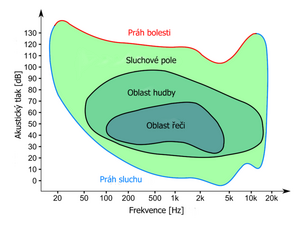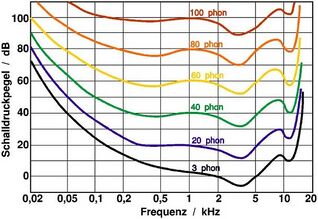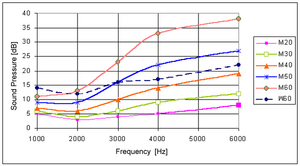Hearing threshold and auditory field
Hearing threshold[edit | edit source]
The auditory field (or area of audibility) is the range of all sounds, that human ear can perceive. Human perception of sound is limited to audible frequencies (approximately 16–20,000 Hz ). For each frequency there is a different intensity difference that we hear. The human hearing organ is most sensitive in the 1–5 kHz frequency range.
Auditory field shape[edit | edit source]
From below, the auditory field is defined by the auditory threshold curve, i.e. the smallest tone, intensity that the observer is able to perceive at a given frequency. It is limited from above by the pain threshold curve. Sounds above this threshold cause a painful sensation and can lead to damage to the hearing organ itself. he perception of sounds is individual and we can find differences even between healthy individuals. The shape of the auditory field also changes with age.
Sound intensity I[edit | edit source]
Sound intensity is the sound wave energy that passes in time 1 with an area of 1 m 2 oriented perpendicular to the direction of sound propagation.
P is the sound wave power, S is the surface area through which the wave passes. The unit is therefore W•m−2.
Sound Intensity L[edit | edit source]
The difference in sound intensity between a weak sound that we can already hear and a strong one that causes us pain at a frequency of 1 kHz is in the order of trillions (10–12 W•m−2 a 1 W•m−2). Therefore, the level of sound intensity in relative units, in bels (B) or decibels (dB) , was introduced . 1 B corresponds to a ratio of sound intensities of 1:10. Therefore, if we increase the sound intensity level by 1 dB, the sound intensity increases by about 26%, which is the smallest difference that a healthy ear can perceive
We assign sound intensity levels L in the range 0 dB to 130 dB to sound intensities I registered by the human hearing organ in the range of 10–12 W•m−2 až 10 W•m−2
The intensity level in whites is determined by the decimal logarithm of the ratio of the intensity, the level of which we determine, to a certain intensity I 0 , which we take as the base (zero level).
Isophones[edit | edit source]
An isophone is a curve of equal loudness. It combines sounds of appropriate frequency and intensity that we perceive as equally strong. A zero isophone is the hearing threshold, an isophone at a level of 120 dB is the pain threshold.
Phone (unit) and Volume level[edit | edit source]
Phono (Ph) is a unit of volume level. The loudness level is called subjective loudness , which is perceived by hearing..
The loudness level is defined so that the loudness level of 1 phon at a frequency of 1 kHz is the same as the sound level unit of 1 dB. For sounds of other frequencies, loudness levels are defined by subjective comparison with the loudness level of a reference tone [1]
Hearing threshold[edit | edit source]
The hearing threshold is the volume, level below which the human ear is unable to detect any sound. [2]
The hearing threshold depends on the condition of the person's hearing apparatus. It is generally defined as the contractual reference value of the sound intensity level (at a frequency of 1 kHz) of the acoustic pressure relative to the atmospheric pressure (p0=2.105 Pa=200 kPa). [3] For adults, the hearing threshold is a reference loudness level of 0 decibels (dB).
Dependence of hearing threshold on sound frequency[edit | edit source]
The hearing threshold is different for different sound frequencies. The standardized hearing threshold for a frequency of 1000 Hz is 0 dB. At lower and higher frequencies than 1,000 Hz, a shift in the hearing threshold is visible. For 30 Hz it is around 60 dB. Conversely, the human ear shows the greatest sensitivity at frequencies around 3,500–4,000 Hz, which corresponds to the resonance frequency ear canal. These frequencies correspond to a hearing threshold of −12 dB. [4]
Dependence of hearing threshold on age[edit | edit source]
With increasing age, so-called sensorineural (perceptual) hearing loss develops. This disorder is caused by the absence or damage of tiny hair cells in the cochlea, which then no longer send signals to the brain, resulting in a shift in the hearing threshold. [5] [6] (see graph "Audibility threshold at high frequencies rises with age").
Links[edit | edit source]
Related Pages[edit | edit source]
References[edit | edit source]
- ↑ UNKNOWN,. Wikipedia [online]. [cit. 2013-12-18]. <https://cs.wikipedia.org/wiki/F%C3%B3n_(jednotka)>.
- ↑ GREENFACTS,. Glossary of audiology terms [online]. [cit. 2013-11-29]. <http://ec.europa.eu/health/opinions/en/hearing-loss-personal-music-player-mp3/glossary/ghi/hearing-threshold.htm>.
- ↑ UNKNOWN,. Wikipedia [online]. [cit. 2013-11-29]. <https://en.wikipedia.org/wiki/Absolute_threshold_of_hearing>.
- ↑ NAVE, R.. Threshold of Hearing [online]. [cit. 2013-11-29]. <http://hyperphysics.phy-astr.gsu.edu/hbase/Sound/earcrv.html>.
- ↑ AUDIONIKA,. O sluchu a sluchových vadách [online]. [cit. 2013-18 - 12]. <http://www.audionika.cz/stranka/o-sluchu-a-sluchovych-vadach>.
- ↑ UNKNOWN,. Age and Shift in Hearing Threshold [online]. [cit. 2013-10-10]. <https://www.engineeringtoolbox.com/age-shift-in-threshold-d_1474.html>.
Sources[edit | edit source]
- GREENFACTS,. Glossary of audiology terms [online]. [cit. 2013-11-29]. <http://ec.europa.eu/health/opinions/en/hearing-loss-personal-music-player-mp3/glossary/ghi/hearing-threshold.htm>.
- UNKNOWN,. Wikipedia [online]. [cit. 2013-11-29]. <https://en.wikipedia.org/wiki/Absolute_threshold_of_hearing>.
- NAVE, R.. Threshold of Hearing [online]. [cit. 2013-11-29]. <http://hyperphysics.phy-astr.gsu.edu/hbase/Sound/earcrv.html>.
- UNKNOWN,. Age and Shift in Hearing Threshold [online]. [cit. 2013-10-10]. <https://www.engineeringtoolbox.com/age-shift-in-threshold-d_1474.html>.
Bibliography[edit | edit source]
- NAVRÁTIL, Leoš a Jozef ROSINA. Medicínská biofyzika. Praha: Grada Publishing, 2005. ISBN 978-80-247-1152-2, str. 282.




